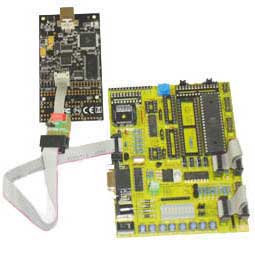As well as having reprogrammable code memory for your program, the AVR has a second memory called EEPROM where you can store user data, like serial numbers, calibration data and other information that needs to be preserved. It is accessed by instructions in your program.
AVRs also have an I/O space, which is used to control the hardware of the microcontroller and store temporary data used by your program. The hardware includes ports, ADC, communication interfaces like I2C (2-wire interface), SPI and UART (serial port), timers and watchdogs that recover from system crashes. All these peripherals are controlled from your program using special instructions. A lot of AVR code programming is about how to setup and control this hardware interface.
Kanda AVR kits, like STK200 and our other AVR training kits, use assembly language to teach you all about the AVR and its hardware setup before moving on to C programming. They also cover the hardware circuit requirements needed to interface with the AVR microcontroller, once you move beyond the AVR board supplied and want to develop your own circuits.
AVR Microcontrollers For Beginners

A final word about Arduino. This is a simplified development system for microcontrollers. It is based on the AVR microcontroller but this is pretty well concealed. It is great for developing a quick project but it won’t really teach you about AVRs or how to program them using real development tools.
Related Information

Thnx. ..it really helps…
All basics are at place with nicely teached…
We use two pins of the microcontroller to drive the brigde. These pins alternate between being +5V/GND and GND/+5V. So effectively, it looks like a 10V peak-to-peak square wave of AC voltage. This technique helps reduce the noise because electronic components tend to have significantly more noise at lower frequencies, which is called 1/f noise, as well as DC offsets. Hope that helps!
This is all well and good, but pretty opinionated. Amtel is by far NOT the only maker of AVR’s, tho that is what you imply. But more importantly, you have not even answered the basic question being asked: What is an AVR? What do the letters stand for, for example??????
Surely blogs should have an opinion? Atmel are the only company who design and manufacturer AVR microcontrollers, although other products are called AVR such as some amplifiers but they are not microcontrollers . Why does it matter what AVR stands for? The accepted opinion is that they stand for Alf and Vergart’s Risc, after the original Norwegian designers of the chip but this is not confirmed by Atmel. But how does that help in understanding what it is?